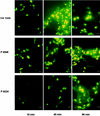Susceptibility of Candida dubliniensis to salivary histatin 3
- PMID: 12499171
- PMCID: PMC149010
- DOI: 10.1128/AAC.47.1.70-76.2003
Susceptibility of Candida dubliniensis to salivary histatin 3
Abstract
Candida dubliniensis is a recently described Candida species associated with oral candidiasis in human immunodeficiency virus (HIV)-infected patients and patients with AIDS. The majority of C. dubliniensis clinical isolates tested to date are susceptible to the commonly used antifungal drugs, including fluconazole, ketoconazole, itraconazole, and amphotericin B. However, the appearance of fluconazole-resistant C. dubliniensis strains in this patient group is increasing. Histatins are a family of basic histidine-rich proteins present in human saliva which have therapeutic potential in the treatment of oral candidiasis. The mechanism of action of histatin is distinct from that of commonly used azole and polyene drugs. Characterization of the antifungal activity of histatin has mainly been carried out using C. albicans but it is also effective in killing C. glabrata and C. krusei. Here we report that C. dubliniensis is also susceptible to killing by histatin 3. The concentration of histatin 3 giving 50% killing (the IC(50) value) ranged from 0.043 to 0.196 mg/ml among different strains of C. dubliniensis. The least-susceptible C. dubliniensis strain, P9224, was found to internalize histatin at a lower rate than the C. albicans reference strain CA132A. The dissociation constant (K(d)) for the least-susceptible strain (C. dubliniensis 9224) was ninefold higher than that for the C. albicans reference strain. These results suggest that histatin 3 may have potential as an effective antifungal agent, particularly in the treatment of oral candidiasis in HIV-infected patients and patients with AIDS in which resistance to the commonly used antifungal drug fluconazole has emerged.
Figures



Similar articles
-
Replacement of Candida albicans with C. dubliniensis in human immunodeficiency virus-infected patients with oropharyngeal candidiasis treated with fluconazole.J Clin Microbiol. 2002 Sep;40(9):3135-9. doi: 10.1128/JCM.40.9.3135-3139.2002. J Clin Microbiol. 2002. PMID: 12202543 Free PMC article.
-
Cross-sectional study of the susceptibility of Candida isolates to antifungal drugs and in vitro-in vivo correlation in HIV-infected patients.AIDS. 1994 Jul;8(7):945-50. doi: 10.1097/00002030-199407000-00011. AIDS. 1994. PMID: 7946104
-
Iranian HIV/AIDS patients with oropharyngeal candidiasis: identification, prevalence and antifungal susceptibility of Candida species.Lett Appl Microbiol. 2018 Oct;67(4):392-399. doi: 10.1111/lam.13052. Epub 2018 Aug 16. Lett Appl Microbiol. 2018. PMID: 30019443
-
Comparison of the epidemiology, drug resistance mechanisms, and virulence of Candida dubliniensis and Candida albicans.FEMS Yeast Res. 2004 Jan;4(4-5):369-76. doi: 10.1016/S1567-1356(03)00240-X. FEMS Yeast Res. 2004. PMID: 14734017 Review.
-
Candida dubliniensis, a new fungal pathogen.J Basic Microbiol. 2002;42(3):207-27. doi: 10.1002/1521-4028(200206)42:3<207::AID-JOBM207>3.0.CO;2-C. J Basic Microbiol. 2002. PMID: 12111748 Review.
Cited by
-
Whole Saliva has a Dual Role on the Adherence of Candida albicans to Polymethylmetacrylate.Open Dent J. 2008;2:1-4. doi: 10.2174/1874210600802010001. Epub 2008 Jan 8. Open Dent J. 2008. PMID: 19088875 Free PMC article.
-
Candida Infections: The Role of Saliva in Oral Health-A Narrative Review.Microorganisms. 2025 Mar 23;13(4):717. doi: 10.3390/microorganisms13040717. Microorganisms. 2025. PMID: 40284554 Free PMC article. Review.
-
In vitro reactive oxygen species production by histatins and copper(I,II).J Biol Inorg Chem. 2009 Feb;14(2):243-51. doi: 10.1007/s00775-008-0444-x. Epub 2008 Oct 31. J Biol Inorg Chem. 2009. PMID: 18975018
-
Fluconazole-Resistant Candida auris Is Susceptible to Salivary Histatin 5 Killing and to Intrinsic Host Defenses.Antimicrob Agents Chemother. 2018 Jan 25;62(2):e01872-17. doi: 10.1128/AAC.01872-17. Print 2018 Feb. Antimicrob Agents Chemother. 2018. PMID: 29158282 Free PMC article.
-
Diagnostic model of saliva peptide finger print analysis of oral squamous cell carcinoma patients using weak cation exchange magnetic beads.Biosci Rep. 2015 May 12;35(3):e00211. doi: 10.1042/BSR20150023. Biosci Rep. 2015. PMID: 26182373 Free PMC article.
References
-
- Beck-Sague, C. M., W. R. Jarwis, et al. 1993. Secular trends in the epidemiology of nosocomial fungal infection in the United States, 1980-1990. J. Infect. Dis. 167:1247-1251. - PubMed
-
- Bercier, J. G., I. Al-Hashimi, N. Haghighat, T. D. Rees, and F. G. Oppenheim. 1999. Salivary histatins in patients with recurrent oral candidiasis J. Oral Pathol. Med. 28:26-29. - PubMed
-
- Boyle, B. M., D. J. Sullivan, C. Forkin, F. Mulcahy, C. T., Keane, and D. C. Coleman. 2002. Candida dubliniensis candidaemia in an HIV-positive patient in Ireland. Int. J. STD AIDS 13:55-57. - PubMed
-
- Calderone, R. A., and W. A. Fonzi. 2001. Virulence factors of Candida albicans. Trends Microbiol. 9:327-335. - PubMed
Publication types
MeSH terms
Substances
LinkOut - more resources
Full Text Sources
Medical

